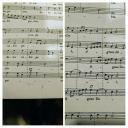Odd notation
-
We are rehearsing de Morales (+1553) Missa super it re mi fa so la, in the 1964 Anglés edition from IMSLP
The edition is normal and useable, but in the Agnus there are two instances of a notation none of us has ever seen or can guess at the meaning of. It appears on the bass line. I'd describe it as "upside down capital J with diaeresis". Picture attached.
Can anyone help?

 20190402_223113-COLLAGE.jpg1024 x 1024 - 220K
20190402_223113-COLLAGE.jpg1024 x 1024 - 220K -
The sign marks the beginning and end of the canon between Tenor I and Bass.
-
Why that sign, though? Is it used for this purpose regularly?
-
Actually that looks like a neum in a German Graduale I was consulted on once. The flag of the virga was curled on the top and bottom, like a candy cane. Fascinating.Thanked by 1CHGiffen
-
It's a stylized R, for "reprise", usually to mark the repeating part of a canon or the petite reprise at the end of a strophe. It also looks a bit like two eyes and a nose, so in grad school we called it a Waldo (as in, "Where's Waldo?")
-
Under the term "petite reprise" and "reprise" I have found some convincing examples, thank-you, @JL.
In this piece, though, it's hard for me to see how to interpret them as reprise marks, because neither the text nor the rhythm seem to propose reprising the whole Agnus as indicated. Could they mean anything else?
Welcome to the MusicaSacra Forum!
To participate in the discussions on Catholic church music, sign in or register as a forum member, The forum is a project of the Church Music Association of America.
Categories
- All Discussions21,074
- General Music Discussion8,206
- Job Openings193
- Management of Music Programs850
- Choral Matters532
- Church Documents and Rubrics524
- CMAA Notes300
- Events713
- For Newcomers: Read First26
- Sacred Polyphony546
- Hymnody871
- Gregorian Chant: General2,694
- ↳ Graduale Romanum and Liber Usualis367
- ↳ Graduale Simplex60
- ↳ Semiology63
- Vernacular Plainsong696
- Anglican Use and Anglican Chant68
- Organ, Other Instruments and Repertoire434
- New Composition/Works in Progress1,288
- Recordings230
- Music for Hispanic Ministry159
- Music Education: Children211
- Music Education: General222
- News Items245
- Positions Wanted2
- General Discussion: Catholicism738
- Amusements176
- General Discussion1,033
- Opinions117

